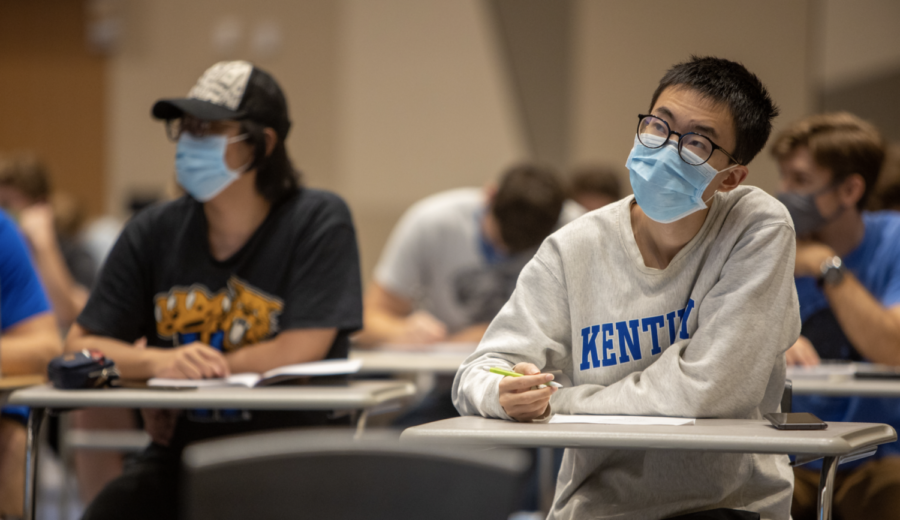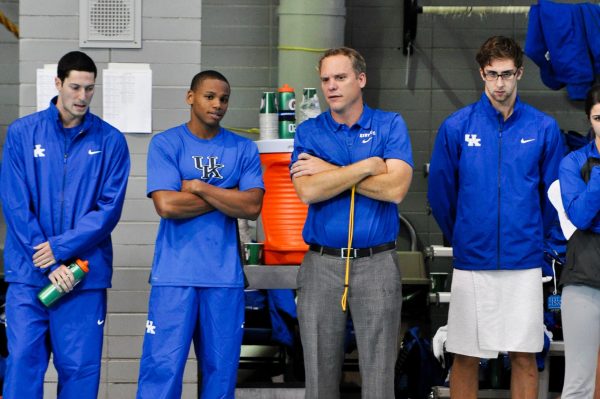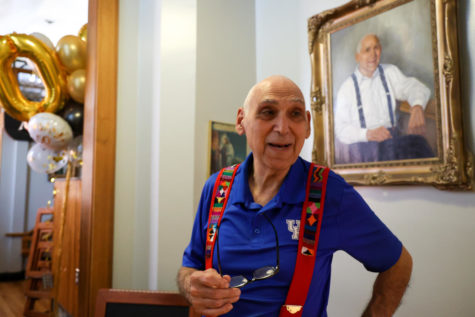In-person, hybrid or online: How do this semester’s courses break down?
September 10, 2020
One month into the fall semester, the university administration, students and professors are working to navigate the unique course delivery methods that have arisen out of the COVID-19 pandemic.
UK announced early on in the planning process that this fall’s courses would come in different formats, some traditional, some virtual.
According to UK registrar Kim Taylor, courses this fall are 37.3 percent in-person, 41.9 percent fully online and 19 percent hybrid instruction.
Numerically, that translates to 1895 traditional courses and 2092 fully online courses.
Taylor said it is important to remember these numbers don’t include courses with enrollment of zero or one, or courses labeled as independent research or clinical hours.
Traditional modality refers to classes that are primarily held face-to-face on the main UK campus; off-campus classes are held in-person at a designated off-campus location; hybrid classes are a blend of in-person and online instruction; internet, web-based meetings are held fully online and compressed video courses are broadcasted live from an in-person meeting to designated remote locations.
Fewer than 2 percent of classes are off campus or compressed video modalities, according to data provided by the registrar’s office.
Different course formats were introduced as a way to balance safety guidelines with academic success.
“Ensuring the health, safety and well-being of all members of our community is always our top priority in everything we do. We then attempted to match the delivery method to best achieve course learning objectives given limitations on physical distancing in our classrooms,” Taylor said.
Each college has a slightly different breakdown of course modalities.
UK’s College of Dentistry has the highest percentage of traditional courses, with 97.8 percent of its courses occurring in-person.
The College of Nursing has the second highest percentage of traditional courses, with 138 of its 195 classes taking place in-person.
The College of Communication and Information, at 20.52 percent, has the lowest percentage of in-person classes, though both Arts and Sciences and Health Sciences are just above 22 percent traditional instruction.
Not all colleges offer all three modalities – the College of Public Health only has in-person (40 percent) or online (60 percent) classes. Dentistry does not offer hybrid courses either, just traditional or fully online.
Some classes may not have changed modality completely but had changed locations to a bigger room or alternating attendance policies depending on room limitations. This factor did play into the decision of whether to switch course modality or not, Taylor said.
Decisions on course modality were also affected by the distancing and masking policies on campus, Taylor said. She said that the difficulty of holding performance-based classes like theater in a masked and distanced environment meant those classes were often switched to hybrid or online modalities.
“Given the limitations of spacing in the classrooms and the requirements for masks, instructors may have decided some content could be delivered more effectively in an online modality,” Taylor said.
However, Taylor said instructors were not directly allowed to choose which mode to teach their class, but rather it was a collaborative decision.
“Because some courses are better suited for certain modalities—and because some colleges strongly encouraged some modalities—it largely depended on the faculty member’s college and the specific course whether they taught in a certain modality,” Taylor said. “These were collaborative decisions of department chairs and faculty members with the overall goal of providing students sufficient options.”
Taylor said no university-wide requirements were given on what course modality instructors must teach their class, but these kinds of decisions were made on a more intimate level.
“On several occasions, the Office of the Provost made it clear that there was not a requirement that any particular faculty member teach in any particular modality, but that it was the responsibility of each college to maintain a mix of course modalities and also to have courses delivered in ways appropriate to support each course’s learning objectives,” Taylor said.
If instructors had been concerned about teaching through the modality they were given, Taylor said those conversations would have then taken place at the department level.
“There would have been discussions of which courses could be taught in which modalities, and which faculty members would then teach those courses, accommodating any concerns of faculty members,” Taylor said.
Some students have expressed confusion about the course modality listed in their myUK portal.
Olivia Johnson, a sophomore psychology major, said her class modality suddenly changed before classes.
“Before coming to campus I had three online classes and three hybrid, but before classes started they switched to all online,” Johnson said.
Anna McCowan, a senior and human health sciences major, said the label for one of her classes never changed in myUK even when the instructor has said the modality has.
“One of my hybrid courses doesn’t actually meet in person, so I don’t know why it is listed as hybrid,” McCowan said.
Rebekah Pearson, a senior special education major, said she experienced similar confusion.
“All 5 of my classes are listed as in-person in myUK, but are formatted in an alternating attendance model, so they are more of a hybrid,” Pearson said.
In addition to the discrepancy with myUK, students have also expressed confusion with some of the course modalities themselves. Mackenzie Hicks, a senior elementary education major, said the hybrid course model has been a confusing adjustment for her.
“I feel much better when there is an organized timeline for my classes rather than not knowing whether or not my class will be in person and if I will have to drive to campus,” Hicks said. “I think the plan looks better on paper than it does executed.”
Students aren’t the only ones still navigating the ins and outs of course modalities.
Johnson said her instructors have expressed concerns over their course modality.
“However, I can tell that they are trying to make class as normal as possible.”
Hicks said multiple of her professors have expressed concerns. One even decided to change their course modality from hybrid to fully online out of fear of spreading COVID-19 through the in-person parts of their hybrid course.
Despite the new formatting, most students said their professors are being adaptive and prioritizing health in their modalities.
Sophie Meadors, a senior broadcast journalism major, said though she has in-person class there have definitely been decisions made that make her feel safer.
“For instance, one of my classes was originally assigned a classroom that was kind of small, but we were able to switch classrooms to better accommodate social distancing when we realized it wouldn’t work in that room. There’s also always hand sanitizer and wipes available in my classrooms, “ Meadors said.
Halee Kinder, a sophomore animal science major, said her professors have worked directly with her to make sure her health and safety is a priority.
“I didn’t realize [one class] was in person class, and when I asked if I could not come in, [my professor] made sure to let me know if I need any help we’ll do what it takes to keep me caught up,” Kinder said.























































































































































